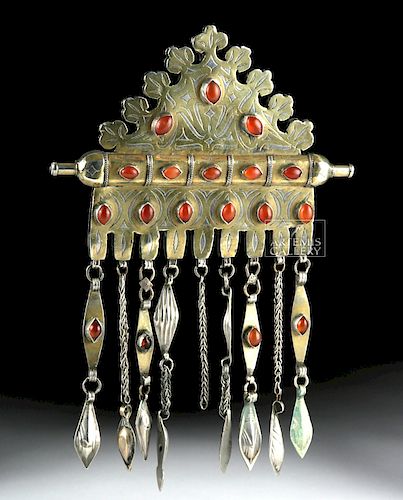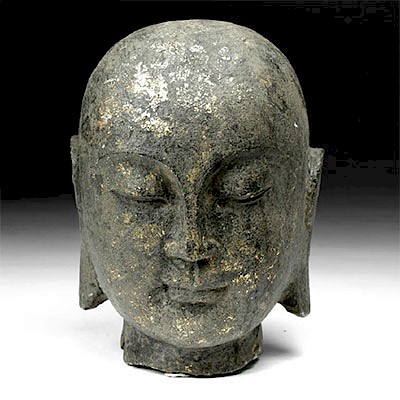19th C. Turkoman Gilded Silver & Agate Bridal Adornment
Lot 125b
About Seller
Artemis Fine Arts
686 S Taylor Ave, Ste 106
Louisville, CO 80027
United States
Selling antiquities, ancient and ethnographic art online since 1993, Artemis Gallery specializes in Classical Antiquities (Egyptian, Greek, Roman, Near Eastern), Asian, Pre-Columbian, African / Tribal / Oceanographic art. Our extensive inventory includes pottery, stone, metal, wood, glass and textil...Read more
Categories
Estimate:
$1,500 - $2,000
Absentee vs Live bid
Two ways to bid:
- Leave a max absentee bid and the platform will bid on your behalf up to your maximum bid during the live auction.
- Bid live during the auction and your bids will be submitted real-time to the auctioneer.
Bid Increments
| Price | Bid Increment |
|---|---|
| $0 | $25 |
| $300 | $50 |
| $1,000 | $100 |
| $2,000 | $250 |
| $5,000 | $500 |
| $10,000 | $1,000 |
| $20,000 | $2,500 |
| $50,000 | $5,000 |
| $100,000 | $10,000 |
| $200,000 | $20,000 |
About Auction
By Artemis Fine Arts
Nov 29, 2018
Set Reminder
2018-11-29 10:00:00
2018-11-29 10:00:00
America/New_York
Bidsquare
Bidsquare : Holiday Glitz - Ancient / Ethnographic Art
https://www.bidsquare.com/auctions/artemis-gallery/holiday-glitz---ancient-ethnographic-art-3672
What to give this holiday season? Think silver, gold, bronze, shiny, glittery, wearable, festive. We ship worldwide and handle all shipping in-house for your convenience. This is one sale you don't want to miss! Artemis Fine Arts info@artemisfinearts.com
What to give this holiday season? Think silver, gold, bronze, shiny, glittery, wearable, festive. We ship worldwide and handle all shipping in-house for your convenience. This is one sale you don't want to miss! Artemis Fine Arts info@artemisfinearts.com
- Lot Description
Western Central Asia (Turkmenistan, Iran, Afghanistan, Pakistan, Russia), Turkoman (Turkmen) people, ca. 19th century CE. A sumptuous gilded silver bridal adornment with 14 inlaid pieces of fiery-colored agate. Nine dangling silver chains and pendants hang from the bottom, with four inlaid pieces of again on the long, flat pendants. The main part of the adornment is incised with floral motifs and also features rope-like decorations around its middle. Three loops on the back and a hollow central tube allowed this heavy ornament to be sewn onto clothing. It likely once decorated a woven textile cap to form a crown, with the dangling parts made to hang over the eyes. Size: 5.75" W x 8.9" H (14.6 cm x 22.6 cm); 163.2 grams
Fabulous jewelry like this was a hallmark of elite men and women in the Turkoman society. Powerful people wore the items they commissioned or gave them as diplomatic gifts to rulers and elites in other countries as a way of showcasing the wealth of their own region. Jewelers worked on commissions from the richest members of society, obtaining precious metal from various mountains in the area, including Ferghana and the Zartalash east of Tashkent. Jewelers worked with a variety of different precious and semi-precious stones, also sourced from far afield. Artisans in cities like Bukhara, Samarkand, and Tashkent kept alive metalworking traditions once common in the medieval period long after Europeans lost them.
Provenance: private Hawaii, USA collection; ex-Beverly Hills, USA collection
All items legal to buy/sell under U.S. Statute covering cultural patrimony Code 2600, CHAPTER 14, and are guaranteed to be as described or your money back.
A Certificate of Authenticity will accompany all winning bids.
We ship worldwide and handle all shipping in-house for your convenience.
#141179Beautiful condition with much of the gilding remaining. One of the dangling chains has lost its pendant. Another pendant seems contemporary with the piece but is clearly made of a different alloy, with a higher copper percentage and subsequently different patina, than the others. Faint patina on surface.Condition
- Shipping Info
-
All shipping is handled in-house for your convenience. Your invoice from Artemis Gallery will include shipping calculation instructions. If in doubt, please inquire BEFORE bidding for estimated shipping costs for individual items.
-
- Buyer's Premium



 EUR
EUR CAD
CAD AUD
AUD GBP
GBP MXN
MXN HKD
HKD CNY
CNY MYR
MYR SEK
SEK SGD
SGD CHF
CHF THB
THB














